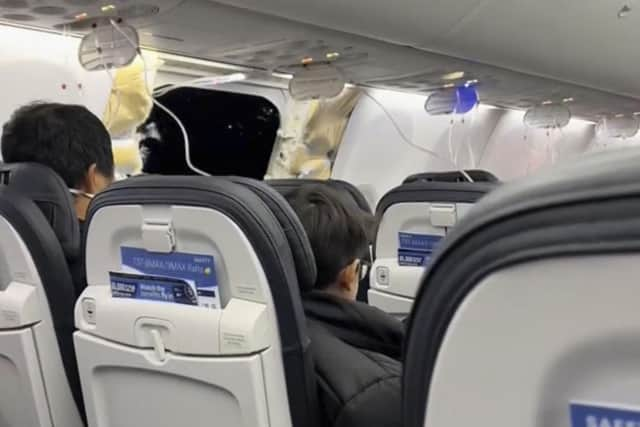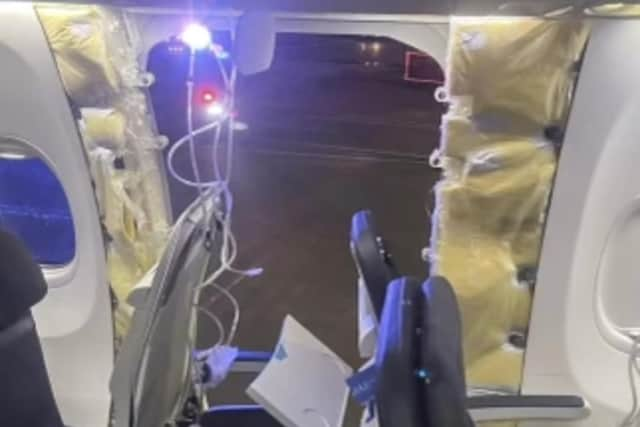Alaska Airlines: Panel which replaced exit door blew out in mid-air drama
No European airlines operate the Boeing 737-9 MAX with an exit door replaced by a panel similar to the one that blew out on an Alaska Airlines flight on Friday, safety regulators have announced.
The European Union Aviation Safety Agency (EASA) update on Sunday followed the US Federal Aviation Administration (FAA) grounding 737-9 MAX aircraft with that configuration pending checks.
Advertisement
Hide AdAdvertisement
Hide AdIt is understood that rear cabin exit doors, midway between the wings and the back of the aircraft, are replaced with panels by airlines operating them with fewer passengers where the additional door is not required to meet evacuation regulations.


EASA said it believed no airlines in Europe had replaced the doors with panels. Turkish Airlines has five 737-9 MAX in service and Icelandair has four, according to aviation analysts Cirium.
Ryanair does not operate the aircraft, with its fleet including a different variant, the 737-8 MAX, which is not affected.
US carrier United Airlines is among those inspecting its 737-9 fleet and said it had “temporarily suspended service on selected aircraft”.
It followed a panel on an Alaska Airlines flight blowing out while the aircraft was climbing to its cruising height after taking off from Portland in Oregon for Ontario, near Los Angeles in California.


The 171 passengers and six crew aboard put on oxygen masks following a rapid loss of cabin air pressure when the incident happened abut six minutes into the flight, at about 16,000ft – around half normal cruising height.
Some minor injuries were reported, and the plane, which had been in service for only two months, made an emergency landing at the same airport about 13 minutes later.
A passenger said a boy sitting in the row beside the panel had had his shirt sucked out of the aircraft. But experts said the outcome could have been much worse if the aircraft had reached cruising altitude, when passengers are normally permitted to take off seat belts and move around the cabin.
Advertisement
Hide AdAdvertisement
Hide AdEASA said it had adopted the FAA’s emergency airworthiness directive, which has grounded affected aircraft until they have been inspected, even though it understood that no airline in the EU “currently operates an aircraft in the relevant configuration”. The 737-9 MAX entered service in 2017.
EASA said: “In the specific set-up covered by the directive, a mid-cabin exit is replaced by a plug-in panel. This configuration is typically adopted by airlines flying lower-density operations, with lower passenger capacity, where this additional exit is not required to meet evacuation safety requirements.”
The UK Civil Aviation Authority said there were no UK-registered 737-9 MAX aircraft and “the impact on UK operated aircraft and consumers is minimal”.
However, it added: “We have written to non-UK and foreign permit carriers to ask inspections have been undertaken prior to operation in UK airspace.”
Cirium said 215 737-9 MAX aircraft were in service, including 79 with United and 65 with Alaska – one in five of the latter’s fleet. However, it did not specify how many of these are operated with panels replacing exit doors.
Evan Smith, a passenger on the Alaska Airlines flight, said: "You heard a big loud bang to the left rear. A whooshing sound and all the oxygen masks deployed instantly and everyone got those on."
Alaska Airlines chief executive Ben Minicucci said: “My heart goes out to those who were on this flight - I am so sorry for what you experienced."
Two 737-8 MAX aircraft crashed in 2018 and 2019, killing 346 people and leading to a near two-year worldwide grounding of all 737-8 and 737-9 MAX aircraft following a fault with the automated flight control system.
Comments
Want to join the conversation? Please or to comment on this article.